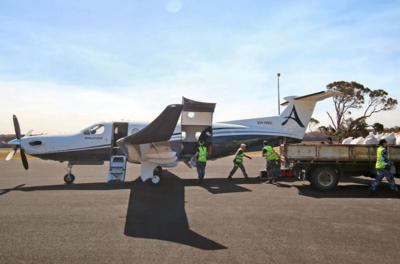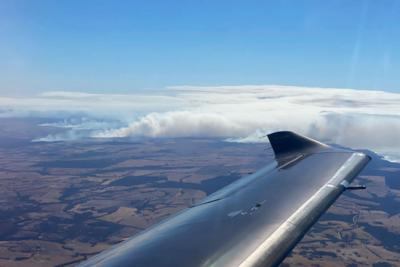Tue, Apr 28, 2020
A Number of Pilatus PC-12 Operators Involved
People around the world will be aware of the fires that burnt millions of hectares of land and killed almost a billion animals around Australia. It was a difficult Australian summer in all respects. In these conditions, it was great to see so many Pilatus family aircraft assisting where they could.

The dense smoke associated with the large-scale bush fires made life very difficult for people in many parts of Australia in early January – and also had a major impact on flying conditions. A thick haze surrounded many parts of South and Eastern Australia for a lengthy period. Poor visibility made it impossible for aircraft to take off or land. When conditions improved, those who were willing were at last able to lend a hand. It was encouraging to see so many owners of Pilatus aircraft join volunteers on the front line.
Simon Hackett, owner of PC-12 NG serial number 1352 did numerous flights down to Kangaroo Island from Adelaide for the ‘South Australian Veterinary Emergency Management’ organisation (SAVEM). Kangaroo Island is a popular tourist destination located half an hour by air from Adelaide, the nearest major city. The island is home to Flinders Chase National Park, where kangaroos, koalas and anteaters live. The national park was almost completely destroyed. The primary purpose of the flights was to transport vets, nurses and sufficient supplies to Kangaroo Island.
Jonathan Merridew assisted “Animals Australia”, one of Australia’s leading animal protection organisations, in his PC-12 serial number 126. Flights consisted of transporting supplies from Lilydale Airport to Mallacoota. Mallacoota, a coastal town in regional Victoria which was cut off from the rest of Australia by blazing fires, featured in the media for weeks on end. 850 kg of chaff and grain were flown over in the PC-12 to feed starving animals.

The Royal Flying Doctor Service also provides round-the-clock support and care across all regions. The RFDS currently operates some 35 PC-12s and 3 PC-24s, which they use to ensure medical care for patients across the Australian continent. The aircraft come with all the medical equipment needed to provide emergency care to patients during the flight.
They also provided additional services to affected areas in the aftermath of the fires. During this difficult period, a significant portion of the wide-ranging health services supplied by the RFDS revolved around providing professional support in the form of mental healthcare and well-being for affected families. These services complement the traditional aeromedical missions flown in PC-12s and PC-24s.
More News
Circle To Runway (Runway Number) Used by ATC to inform the pilot that he/she must circle to land because the runway in use is other than the runway aligned with the instrument appr>[...]
Aero Linx: National Aviation Safety Foundation (NASF) The National Aviation Safety Foundation is a support group whose objective is to enhance aviation safety through educational p>[...]
At Altitude Of About 250-300 Ft Agl, The Airplane Experienced A Total Loss Of Engine Power On November 6, 2024, at 1600 central standard time, a De Havilland DHC-1, N420TD, was inv>[...]
From 2009 (YouTube Edition): Three Hour Flight Was 'Flawless' -- At Least, Until Mother Nature Intervened For anyone who loves the aviation business, this was a VERY good day. Afte>[...]
Also: AMA Names Tyler Dobbs, More Falcon 9 Ops, Firefly Launch Unsuccessful, Autonomous F-16s The Air Force has begun ground testing a future uncrewed jet design in a milestone tow>[...]
 ANN's Daily Aero-Term (05.05.25): Circle To Runway (Runway Number)
ANN's Daily Aero-Term (05.05.25): Circle To Runway (Runway Number) ANN's Daily Aero-Linx (05.05.25)
ANN's Daily Aero-Linx (05.05.25) NTSB Prelim: De Havilland DHC-1
NTSB Prelim: De Havilland DHC-1 Classic Aero-TV: The Boeing Dreamliner -- Historic First Flight Coverage
Classic Aero-TV: The Boeing Dreamliner -- Historic First Flight Coverage Airborne-NextGen 05.06.25: AF Uncrewed Fighters, Drones v Planes, Joby Crew Test
Airborne-NextGen 05.06.25: AF Uncrewed Fighters, Drones v Planes, Joby Crew Test




